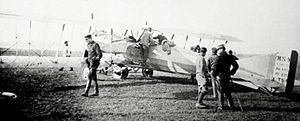Top speed 156 km/h First flight July 1914 | Wingspan 18 m | |
 | ||
The Morane-Saulnier T was a bomber aircraft developed in France in 1914 and produced in small numbers during World War I.
Contents
Design and development
The Morane-Saulnier T was a large, five-bay biplane of conventional configuration, with unstaggered wings of equal span. The conical rear fuselage and large triangular vertical stabilizer were reminiscent of a scaled-up version of some Morane-Saulnier fighter designs. The engines were mounted tractor-fashion in streamlined nacelles supported by struts in the interplane gap and the propellers were fitted with large spinners. The landing gear consisted of two main units, each of which had two wheels joined by a long axle, plus a tailskid and an auxiliary nosewheel. Three open cockpits in tandem were provided: one in the nose for a gunner, and others for the pilot and a second gunner placed further back.
Although designed as a bomber, the French Army ordered the type in 1916 hoping to use it either as a bomber escort or reconnaissance aircraft. While this order called for 100 aircraft, only a small number were built before production was cancelled.
Specifications
Data from Jane's Fighting Aircraft of World War I, 117
General characteristics
Performance
